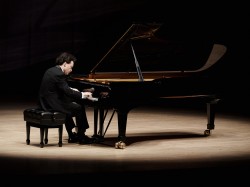 Evgeny Kissin held an appreciative audience in his thrall May 1. Roy Thomson Hall was filled from top to bottom including the choir loft and dozens of stage seats for the Russian-born pianist's first solo recital in Toronto in 15 years. Three rows of seats on either side of the stage marked the outer edge of an umbrella of light that illuminated Kissin as he put his inimitable stamp on Beethoven's “Waldstein” Sonata, Prokofiev's Sonata No.4, three nocturnes and six mazurkas of Chopin as well as Liszt's Hungarian Rhapsody No.15 “Rákóczi March.” The Prokofiev, which ended the concert's first half, elicited a spontaneous standing ovation. The final notes of the Liszt at program's conclusion generated even more response, four standing ovations, three of which resulted in encores, culminating in Prokofiev's March from the Love for Three Oranges. It was an adoration complete with whoops, cheers and even a spate of unified rhythmic clapping.
Evgeny Kissin held an appreciative audience in his thrall May 1. Roy Thomson Hall was filled from top to bottom including the choir loft and dozens of stage seats for the Russian-born pianist's first solo recital in Toronto in 15 years. Three rows of seats on either side of the stage marked the outer edge of an umbrella of light that illuminated Kissin as he put his inimitable stamp on Beethoven's “Waldstein” Sonata, Prokofiev's Sonata No.4, three nocturnes and six mazurkas of Chopin as well as Liszt's Hungarian Rhapsody No.15 “Rákóczi March.” The Prokofiev, which ended the concert's first half, elicited a spontaneous standing ovation. The final notes of the Liszt at program's conclusion generated even more response, four standing ovations, three of which resulted in encores, culminating in Prokofiev's March from the Love for Three Oranges. It was an adoration complete with whoops, cheers and even a spate of unified rhythmic clapping.
How does Kissin evoke such a response? His immersion in the music is total without any apparent barrier between player and score. The notes flow naturally even when, as in the Beethoven, the pianist's tempo changes may not necessarily be those of the composer. Or at least they appear to, with an inevitability that suggests they're part of a series of taut strings or wires. Kissin's exceptional technique seems effortless, but it's never the focus of his playing, only its servant. His tone colour was strikingly different for each of the four composers. The most striking feature of his playing for me was his pellucid piano, the translucent quality of the soft passages.
Once the development section of the Waldstein was well underway we were treated to a progression of the demonic, the placid, the lyrical, with an architectural structure that combined logic and sensitivity, saving the best for the last. So much so indeed, that applause rippled through the hall. The second movement's strong and noble theme was marked by forward-thrusting tension, seemingly the result of Kissin's implacable control. The third movement's main melody was played with unsurpassable attention to big dynamic contrasts. Its first appearance felt as if it were being blown by a breeze; its later chords were assertive even as Beethoven's triumphant ending was acknowledged with deep respect. By then Kissin's magic was hard to resist.
The Prokofiev sonata's moody beginning soon gave way to a more angular tonality than in the Beethoven. Little sardonic phrases reminiscent of the composer's Visions fugitives set the stage for a plaintive, crystalline lullaby-like tune at the emotional centre of the second movement. The finale was playful and virtuosic with a hint of Peter and the Wolf; its tuneful chromaticism led to the evening's first standing ovation.
Chopin's Nocturne Op.9, No.1 was wholly magical. Kissin's tone was at its most rounded, its pellucid quality most pronounced. His left hand, which was tightly wound, propelled the piece, never losing its impetus even at its slowest. Op.9, No.2 felt like a look back in time, like a nostalgic memory, the pianism again always controlled, especially the rubato. Op.48, No.1 was different in character, big and chordal (albeit a touch brittle) but again mesmerizing.
The Mazurka Op.6, No.1 with its typically idiosyncratic dance rhythm re-enforced my perception that Kissin plays more sensitively in the soft passages. The rest of the mazurka set (Op. 6, Nos. 2 and 3, Op.7, Nos. 2 and 3 and Op. 41, No.1) ran the gamut from the animated to the stately and formal, from the graceful and intimate to the fiery; Kissin's playing brimmed over with life.
The Liszt brought Kissin's technique to the fore with flashing fingers dazzling, priming the crowd for more.



